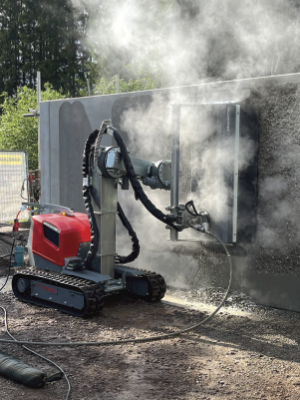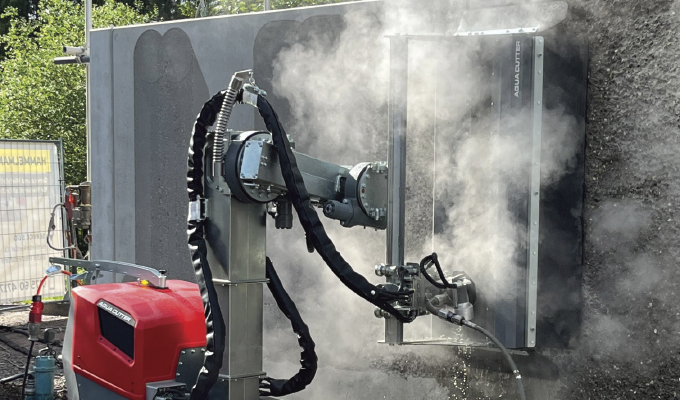Technology is constantly changing and at an accelerated pace. Think of buying a new car, for example. Today’s models have a list of new features, such as built-in wireless cellphone networks and automatic lane changing. These features weren’t even thought of by the average consumer a few years ago.
The same holds true for hydrodemolition equipment. Contractors are no longer competing against jackhammers and hand lances, but rather the latest hydrodemolition advancements. While older models still run and are faster and more effective than handheld tools, new hydrodemolition technology offers far more functionality, and the benefits are anything but trivial. Recent advancements shave time and provide better results, which ultimately gives contractors who adopt new technology a strategic opportunity for growth, innovation, and improved results.

EASE OF USE
Many contractors worry about making the leap to new technology, but with user-friendly features and an intuitive design, today’s hydrodemolition robots are easier to operate than ever. Dedicated support and training are also available to ensure the entire crew feels confident and capable. Older machines, which have fewer automated functions, tend to require more operator experience and intuitive understanding to initially get the settings right. Modern machines’ settings paired with a supportive manufacturer make it far easier for an operator with basic training to confidently run equipment.
With a state-of-the-art operating system, users can set parameters tailored to the specifications in which they need to remove concrete and save those presets for future use. Storing these parameters also provides a good point of reference for reviewing the machine’s production after a job and where potential adjustments could be made. Should the machine’s parameters require any tweaks, it can be as simple as fine-tuning the settings. With older systems, some changes required an operator with extensive knowledge and years of experience.
Some new machines also allow users to say goodbye to manually keeping maintenance logs. Modern machines present clear, easy-to-understand error messages should a problem occur, slashing potential troubleshooting time.
Implementing any change to an equipment fleet will have a learning curve, but modern technology is designed to make the transition as seamless as possible. With user-friendly interfaces, preset parameters and easily accessible training materials, contractors and their teams can quickly adapt.
LANCE MOVEMENT
For most of the hydrodemolition industry’s 30-plus years, simply being able to execute hydrodemolition was enough to qualify as cutting edge. Controlling a water jet through mechanical means was a safer, faster, more sophisticated way to remove concrete compared to a jackhammer or hand lance.
Fairly recently, manufacturers introduced robots with a new lance movement to the market. They harness the benefits of both the oscillating and rotating lance movements. The result is a water jet that moves back to front and right to left, creating a figure 8, or infinity, pattern.
The infinity pattern creates constant oscillation speed that results in greater production. Furthermore, it creates a rough but even result and virtually eliminates pipe holes, leaving behind the ideal bonding surface. Creating the perfect profile for superior bonding strength results in repairs that can last up to three times longer. This will please project engineers and prevent the job from being held up by subpar results.
Users can also adjust the machine to fluctuate speeds in different zones of the work area for deeper or more shallow removal where needed. This is another efficiency-enhancing feature, allowing operators to complete the removal in a single pass. For example, if the job requires removal 4 inches deep for the first half of the pass and 2 inches for the other section, the operator can set zones to accomplish this in one go. Operators can also set new machines to cut in a variety of shapes. So, the triangle shape left over from something like a bridge joint no longer needs to be removed manually by jackhammers or hand lances.
When an operation implements a machine that uses the infinity pattern, they’re making the most efficient use of all the force at their disposal. Contractors using equipment with an infinity pattern will typically increase efficiency by 15 to 20 percent, depending on the scope of the work. With the proper settings and depending what settings are changed, that number could increase to 50 percent. This can save significant time and money for fuel.
IMPROVED COMPONENTS
Modern hydrodemolition machines’ components have more functionality for improved performance. For example, today’s hydrodemolition robots have a sensor in their hoist system to set the height of the hood, eliminating the need for operators to manually check. While some may think additional elements increase the likelihood of breakdowns, that isn’t the case. Components in new machines are designed to last and require less attention. Rollers, for example, had to be tightened daily on old machines. Today’s rollers use more components, are preset and much more durable, allowing operators to approach them with a set-it-and-forget-it mentality.
The new sensors on hydrodemolition robots have made great strides in terms of reliability. They’re well-sealed mechanisms and handle stress from operation, meaning far less upkeep. Previously, if a sensor was tied to a cable, and the cable needed to be replaced, the sensor did as well. With optimized sensors, one can simply replace the cable and get back to work. New and improved components minimize downtime and keep projects on track.
Speaking of tracks—those can impact a project’s quality and efficiency. On a bridge job, for instance, operators may have to drive the machine a couple-hundred feet to the work area. New track systems allow the hydrodemolition robot to travel 50 meters per minute opposed to 30 with an older machine. The modern track systems also provide a smoother ride, reducing machine wear and increasing stability during operation.
OPTIMUM RESULTS
Contractors are no longer competing with jackhammers and hand lances. They are competing with new hydrodemolition technology that is rapidly building on yesterday’s advancements. Contractors adopting the latest technology invest in their team’s success and company’s future by maximizing their potential.
about the author
Keith Armishaw is the business development manager for Aquajet’s North American subsidiary. He has more than 25 years of industry and leadership experience. Aquajet, which was acquired by Brokk AB in 2016, is an industry leader in hydrodemolition machines and solutions, both in terms of quality and volume. For more, visit www.aquajet.se.


